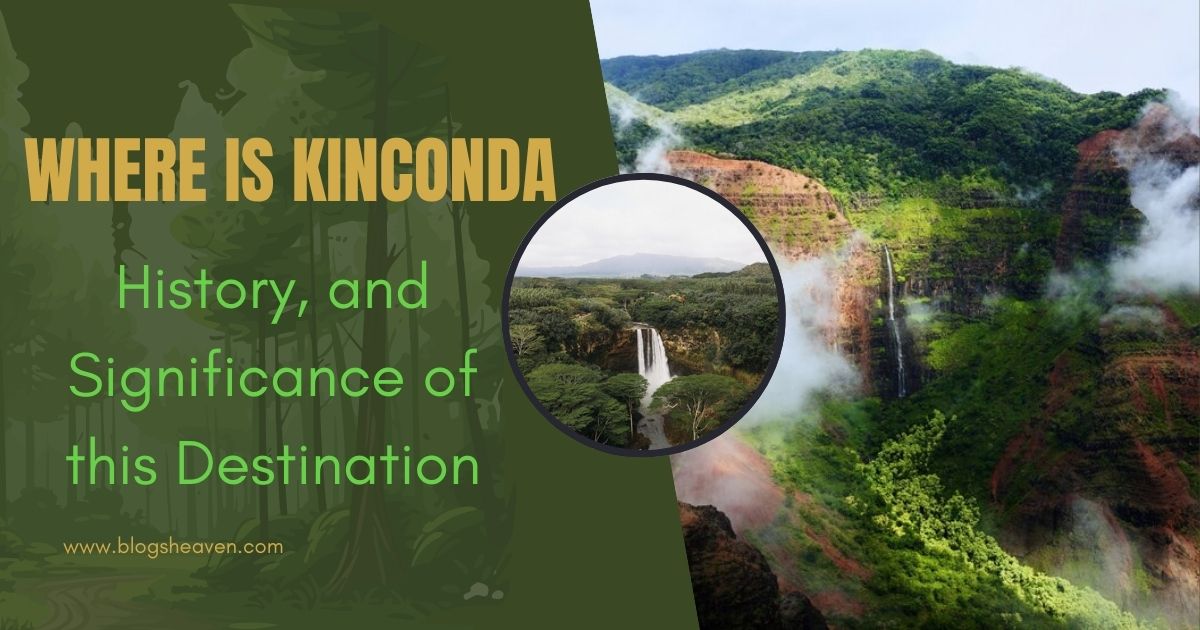Kinconda might not be a name that immediately rings a bell, but it’s a location rich in history and culture. Often hidden from the mainstream travel itinerary, it offers a unique glimpse into a world marked by natural beauty and intriguing cultural heritage. But where exactly is Kinconda? And why is it significant? Let’s delve into the story of this lesser-known destination and uncover its geographical location, cultural background, and potential as a travel destination.
Understanding the Geographical Location of Kinconda
Kinconda is a hidden gem located in the heart of Africa. It lies within the borders of the Democratic Republic of the Congo (DRC), a nation known for its vast natural resources and diverse landscapes. Specifically, it is situated in the southwestern part of the DRC, within the province of Kasai. This region is famous for its rolling hills, rivers, and tropical forests, making it a captivating yet rugged environment.
The Historical Background of Kinconda
The history of Kinconda is as complex as it is fascinating. While not widely documented, Kinconda has been influenced by various tribal communities, colonial powers, and political movements. The region has experienced shifts in power, trade, and tradition over centuries. Local communities have preserved their customs, passing them down through generations, which gives it a distinctive cultural richness.
Kinconda’s Role in Regional Trade and Economy
Historically, Kinconda has played a role in regional trade, especially in agricultural goods. The fertile lands in the surrounding areas support crops like maize, cassava, and yams. Trade routes, although rudimentary, have connected Kinconda to neighboring towns, allowing for the exchange of goods. Kinconda’s location within the resource-rich DRC has also allowed for the extraction of minerals and gemstones, contributing modestly to the local economy.
The Influence of Colonialism on Kinconda
During the colonial period, the Congo endured significant changes under Belgian rule. Kinconda was no exception, experiencing an influx of missionaries, traders, and colonial administrators. This led to changes in traditional practices, religion, and economy. However, the resilient communities of Kinconda have managed to retain much of their indigenous culture, blending it with the colonial influences in a way that is uniquely their own.
The Cultural Landscape of Kinconda
Kinconda is home to a vibrant cultural tapestry. The local languages, traditional dance forms, and storytelling traditions are integral parts of life in it. Communities here practice rites of passage, seasonal celebrations, and other rituals that showcase their deep connection to nature and spirituality. For visitors, witnessing these traditions offers a profound insight into the way of life in this region.
Natural Attractions and Biodiversity in Kinconda
The region surrounding Kinconda boasts breathtaking natural attractions. From rivers and waterfalls to lush forests,it is an area of ecological significance. It supports a range of wildlife, including primates, birds, and unique plant species. The biodiversity here is impressive, but it’s also fragile, with conservation efforts being essential to protect these ecosystems from deforestation and mining activities.
Travel and Accessibility to Kinconda
Reaching Kinconda is an adventure in itself. Due to the limited infrastructure in the DRC, accessing it requires careful planning. Most visitors would need to fly into one of the main airports in Kinshasa or Lubumbashi, then travel by car or local transport to Kasai province. The journey may take several hours, involving a mix of paved roads and rough terrain, but for adventurous travelers, the journey is worth it.
What to Expect When Visiting Kinconda
Visitors to Kinconda should prepare for a journey that is both challenging and rewarding. Unlike popular tourist destinations, it lacks luxury amenities. Accommodations are modest, often provided by local guesthouses or small inns. However, the lack of modern conveniences is compensated by the warm hospitality of the local people. Travelers can expect a unique, immersive experience that brings them closer to nature and local culture.
Unique Traditions and Festivals in Kinconda
Kinconda’s festivals and cultural events are some of its most captivating aspects. Seasonal festivals, harvest celebrations, and traditional dances are held at various times throughout the year. These events are opportunities for locals to gather, celebrate, and connect with their heritage. For visitors, participating in these festivals can be a deeply enriching experience, offering an authentic glimpse into the local culture.
The Cuisine of Kinconda
Kinconda’s cuisine reflects the agricultural wealth of the region. Dishes here are primarily plant-based, featuring staples such as cassava, maize, and various leafy greens. Popular dishes include cassava porridge and vegetable stews, often seasoned with locally sourced herbs and spices. Meat, when available, usually includes locally raised chicken or fish from nearby rivers. For travelers, trying these dishes is a must to experience the flavors of it.
Challenges Faced by Kinconda
Kinconda, like many regions in the DRC, faces numerous challenges. Limited infrastructure, lack of healthcare facilities, and economic instability are major issues. Additionally, political tensions and occasional conflicts in the DRC can affect the safety and stability of it. Despite these obstacles, the resilience and resourcefulness of the local population are evident in their commitment to preserving their land and culture.
Conservation Efforts
Conservation is crucial in Kinconda due to its rich biodiversity. Efforts to protect the forests and wildlife are growing, often led by local communities and small organizations. These initiatives aim to prevent deforestation, illegal mining, and poaching. Supporting these conservation efforts is essential to maintaining the natural beauty and ecological balance of the region.
Kinconda as an Emerging Travel Destination
Kinconda is gradually gaining attention as an off-the-beaten-path travel destination. Eco-tourism holds promise here, offering an alternative source of income for the local communities while fostering awareness about conservation. As awareness of Kinconda’s natural and cultural offerings grows, more travelers are drawn to explore its unique landscapes and heritage.
Safety Considerations for Travelers
Travelers to Kinconda should take safety precautions due to the remote nature of the area. Checking current travel advisories is recommended, as well as hiring local guides who are familiar with the region. Respecting local customs and following guidance from local authorities can enhance the travel experience while ensuring safety.
Why Visit Kinconda?
Kinconda is a place for those seeking an authentic, unfiltered travel experience. It offers a chance to witness cultural practices untouched by modern commercialization. For those with a passion for nature, Kinconda’s landscapes and wildlife offer a rewarding journey into the heart of Africa’s natural beauty. It may not be for everyone, but it’s a hidden gem for those with an adventurous spirit.
Conclusion
Kinconda, nestled in the DRC’s Kasai province, is a remarkable destination filled with history, culture, and natural beauty. Despite its challenges, it has managed to retain its cultural heritage and ecological treasures. For those seeking an authentic experience and willing to venture off the usual travel path, it offers an unforgettable journey. Through responsible tourism and conservation efforts, it has the potential to shine as a unique destination in Africa’s travel landscape.
FAQs
Is it safe to travel to Kinconda?
Travelers should take precautions and check the latest travel advisories. Hiring a local guide is recommended.
What is the best way to reach Kinconda?
It can be accessed by flying into Kinshasa or Lubumbashi, followed by local transport to Kasai province.
What is the main attraction in Kinconda?
It is known for its natural beauty, including rivers, forests, and cultural festivals.
What kind of food is available in Kinconda?
Local cuisine includes cassava, maize, vegetables, and occasional fish or chicken.
Are there accommodations available in Kinconda?
Accommodation options are modest, with local guesthouses and inns providing basic amenities.











